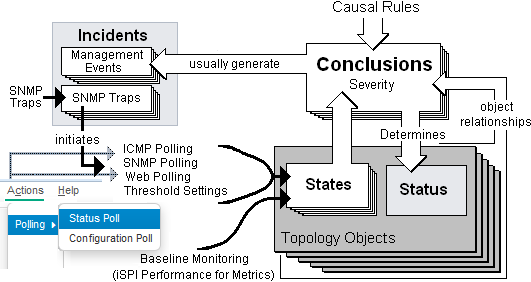Searching the Help
To search for information in the Help, type a word or phrase in the Search box. When you enter a group of words, OR is inferred. You can use Boolean operators to refine your search.
Results returned are case insensitive. However, results ranking takes case into account and assigns higher scores to case matches. Therefore, a search for "cats" followed by a search for "Cats" would return the same number of Help topics, but the order in which the topics are listed would be different.
| Search for | Example | Results |
|---|---|---|
| A single word | cat
|
Topics that contain the word "cat". You will also find its grammatical variations, such as "cats". |
|
A phrase. You can specify that the search results contain a specific phrase. |
"cat food" (quotation marks) |
Topics that contain the literal phrase "cat food" and all its grammatical variations. Without the quotation marks, the query is equivalent to specifying an OR operator, which finds topics with one of the individual words instead of the phrase. |
| Search for | Operator | Example |
|---|---|---|
|
Two or more words in the same topic |
|
|
| Either word in a topic |
|
|
| Topics that do not contain a specific word or phrase |
|
|
| Topics that contain one string and do not contain another | ^ (caret) |
cat ^ mouse
|
| A combination of search types | ( ) parentheses |
|
The NNMi Causal Engine and Incidents
The Causal Engine extensively evaluates network issues and determines the root cause for you, whenever possible, sending incidents to notify you of problems.
The NNMi Causal Engine defines root cause in terms of symptoms. To do so, it uses a set of rules to define relationships for fault and performance (thresholding) symptoms and root causes. Sources of symptom information include SNMP traps and the monitoring information from the State Poller, which includes an object's State. See The NNMi Causal Engine and Object Status and How NNMi Gathers Incidents for more information.

The NNMi Causal Engine performs the following tasks:
- Generates notifications about problems.
- Generates conclusions that relate to the root cause of the problem.
-
Determines whether the incident should be correlated or suppressed.
Tip An incident that is correlated with a Root Cause Parent Incident has a Correlation Nature of
 Secondary Root Cause. These incidents can be examined using the All Incidents view, but do not appear as Key Incidents or Root Cause incidents. See Incident Views Provided by NNMi for more information.Incident correlation scenario (
Secondary Root Cause. These incidents can be examined using the All Incidents view, but do not appear as Key Incidents or Root Cause incidents. See Incident Views Provided by NNMi for more information.Incident correlation scenario ( click here)
click here)
The
NodeDownincident correlates theInterfaceDownincident from one-hop neighbor interfaces, according to the following scenario:When an interface goes down, a
NodeDownepisode begins for the neighboring node, which exists for the duration of 300 seconds.Within that duration, if the node goes down, the
InterfaceDownincident is correlated with theNodeDownincident.The
InterfaceDownincidents from all one-hop neighbors are correlated with theNodeDownincident. The network operator can review theInterfaceDownincidents as supporting evidence for theNodeDownincident.Incident suppression scenario ( click here)
click here)
The
AddressNotRespondingincident is suppressed by theInterfaceDownincident, according to the following scenario:When an IPv4 address stops responding to ICMP, an episode begins, which exists for the duration of 60 seconds.
Within that duration, if the interface associated with that IPv4 address goes down, the Causal Engine concludes that the interface down condition caused the IPv4 address to stop responding.
Therefore, the
AddressNotRespondingincident is not generated. Only theInterfaceDownincident is generated.To ensure that the
InterfaceDownincident is detected within the duration, the Causal Engine issues a named poll for that interface. The incident enables the network engineer to fix the root cause of the problem which, in this case, is the interface.If the interface does not go down during the episode, the Causal Engine generates an
AddressNotRespondingincident. If the interface goes down after the episode, NNMi generates theInterfaceDownincident. In this case, the network engineer has to treat the two problems separately. - Closes incidents that are no longer valid (for example, when a "Cold Start" trap is received a short time after a "Node Down" incident was generated because a device was recently rebooted).
- Creates a parent-child relationship between incidents that are all related to one problem (for example, a "Node Down" incident contains a child "Interface Down" incident for each neighboring interface of the node).
- Creates parent-child relationships between incidents that are correlated using the Custom Correlation configuration. NNMi's Custom Correlation feature enables administrators to add customized rules for when and how to correlate incidents. See Configure Custom Correlations for more information.
The Causal Engine actively solicits symptoms during analysis and reacts dynamically to topology changes. The Causal Engine uses the following three stages to help determine and display root cause incidents and their related conclusions.
| Causal Engine Stages | Description |
|---|---|
| Condition Listener | Collects symptoms from NNMi processes and services. |
| Hypothesis engine | Analyzes these symptoms to determine relationships until a root cause is reached. |
| Blackboard | Based on the information sent by the hypothesis engine, the blackboard updates a device's status and posts any related incidents. |
The NNMi Causal Engine analyzes the health of your network and provides the ongoing health Status reading for each object it monitors. See The NNMi Causal Engine and Object Status and The NNMi Causal Engine and Monitoring for more information.
Related Topics
We welcome your comments!
To open the configured email client on this computer, open an email window.
Otherwise, copy the information below to a web mail client, and send this email to network-management-doc-feedback@hpe.com.
Help Topic ID:
Product:
Topic Title:
Feedback:





